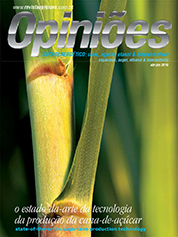José Tadeu Coleti
Director of Coleti Consultoria
Op-AA-24
The minimum preparation system for sugarcane: sustainable since its implementation
The sugarcane version of the DPS (direct planting system) is the MPS (minimum preparation system), thus named on account of the historically strong mechanization of soil revolving in a culture´s implementation. Actually, one witnesses the first instance of a technology that is being implemented, while at the same time it is tearing down paradigms until recently viewed as untouchable.
One may state that as a consequence of the already consolidated grain-DPS experience of 35 years, the cane MPS will progress very quickly, even because of the very fundamentals of the system. What are the main propositions of the DPS?
1. Mitigate the impact of soil preparation in reducing original carbon content;
2. Contribute to the good formation of the radicular system, eternalizing macro-porosity;
3. Benefit the inter-relationship of plant – micro-or-ganisms and soil;
4. Warrant the positive symbiosis between micorrhyzal fungi and the radicular system, aiming at higher nutri-tional efficiency;
5. Add to soil, each year, around 12 to 14 t.ha-1 of straw, aiming at maintaining carbon inventory.
The sugarcane scenario for the 21st. Century is set naturally along the line of minimum preparation: mechanized crude sugarcane harvesting expanding at a quick pace; maintenance of ratoon covering with straw; superficial application of fertilizer and corrective materials, eliminating mechanical scarification; chemical desiccation of ratoons when renewing sugarcane plantations.
Sugarcane´s natural vocation is quite apparent in terms of it holding the title as the culture with the best sustain-ability indicators of all economically significant cultures, perhaps even as the most sustainable of commercially relevant cultures! To reach this punctuation, it suffices to adopt minimum soil revolving in the planting activity, which is already a reality in several areas of the productive sector.
What in the grain culture requires true juggling skills in setting the sequence of species to achieve a straw volume deemed ideal to provide DPS sustainability, with sugarcane this is natural: every year, 12 to 15 t.ha-1 are deposited and this process is repeated in a cycle of 5 to 7 years, at the end of which soil will present clear signs of recovery of organic material levels.
The state-of-the-art in sugarcane minimum preparation technology, in our viewpoint, is in the expansion phase in different modalities, while also in a synchronization process of the steps to be followed to consolidate the system. Thus, the first step was to specify the equipment best suited to comply with the minimum revolving proposition, provided the functionability of decompressing without destroying interesting aggregates was preserved.
Robust as it need be to fulfill its task, the subsoiler/delumper stood out as the ideal equipment, combining parabolic shafts with a set of helicoidal springs that benefit the decompression of soil without breaking it apart, cutting disks that prevent straw from clustering and grading rolls that assure final preparation of soil for planting. The second step consists of setting the best time to perform the desiccation of the ratoons to be revitalized. To that end, there is also a process to be followed:
a. advance programming of areas to be revitalized;
b. realization of soil correction tasks following the harvesting;
c. start desiccation exactly when the germinating leaf surface will best react, never allowing the formation of basal internodes;
d. associate desiccation with chemical deinfestation in the case of areas infested with perennial weeds;
e. prevent infestation through annually recurrent weeds in the case of areas with no rotation;
f. prioritize to the maximum the introduction of leguminous plants in the land´s close season, preferably crotalaria, or to associate it with the commercial farming of grain (soybean/peanuts).
The expansion of sugarcane to pasture land or land with grain plantations, as has been occurring for a long time in agricultural regions in the states of Mato Grosso do Sul, Minas Gerais, Mato Grosso and Goiás, has greatly contributed to its introduction also into the MPS line. The outcome has begun to validate such practice, resulting in high productivity, and the outlook of long-life sugarcane plantations.
Amidst this true revolution in the conventional soil preparation system, apart from the evident high-lighting of a culture´s sustainability, what stands out is a significant cost reduction resulting from the suppression of harrows and ploughs. Specialists in soil preparation for planting calculate a reducer effect of 32%. The definitive entry of sugarcane into a sustainable line of agro-technology necessarily involves paying attention to the inter-relationship of fertility, soil biology and plant nutrition, whereas this change in paradigms starts upon its implementation: minimal soil revolving must be sought!




